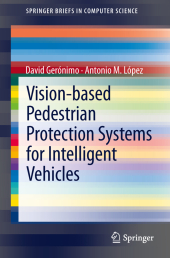 Neuerscheinungen 2013Stand: 2020-01-07 |
Schnellsuche
ISBN/Stichwort/Autor
|
Herderstraße 10
10625 Berlin
Tel.: 030 315 714 16
Fax 030 315 714 14
info@buchspektrum.de |

David Gerónimo, Antonio M. López
(Beteiligte)
Vision-based Pedestrian Protection Systems for Intelligent Vehicles
2014. 2013. x, 114 S. 42 SW-Abb., 1 Tabellen. 235 mm
Verlag/Jahr: SPRINGER, BERLIN 2013
ISBN: 1-461-47986-X (146147986X)
Neue ISBN: 978-1-461-47986-4 (9781461479864)
Preis und Lieferzeit: Bitte klicken
Pedestrian Protection Systems (PPSs) are on-board systems aimed at detecting and tracking people in the surroundings of a vehicle in order to avoid potentially dangerous situations. These systems, together with other Advanced Driver Assistance Systems (ADAS) such as lane departure warning or adaptive cruise control, are one of the most promising ways to improve traffic safety. By the use of computer vision, cameras working either in the visible or infra-red spectra have been demonstrated as a reliable sensor to perform this task. Nevertheless, the variability of human´s appearance, not only in terms of clothing and sizes but also as a result of their dynamic shape, makes pedestrians one of the most complex classes even for computer vision. Moreover, the unstructured changing and unpredictable environment in which such on-board systems must work makes detection a difficult task to be carried out with the demanded robustness.
In this brief, the state of the art in PPSs is introduced through the review of the most relevant papers of the last decade. A common computational architecture is presented as a framework to organize each method according to its main contribution. More than 300 papers are referenced, most of them addressing pedestrian detection and others corresponding to the descriptors (features), pedestrian models, and learning machines used. In addition, an overview of topics such as real-time aspects, systems benchmarking and future challenges of this research area are presented.
1. Introduction.- 2. Candidates Generation.- 3. Classification.- 4. Completing the System.- 5. Datasets and Benchmarking.- 6. Conclusions.


